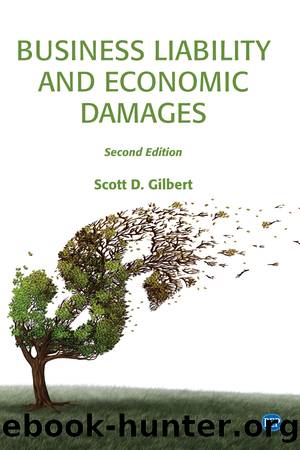Business Liability and Economic Damages, Second Edition by Scott D. Gilbert

Author:Scott D. Gilbert [Scott D. Gilbert]
Language: eng
Format: epub
Publisher: Business Expert Press
Published: 2020-06-24T16:00:00+00:00
A Taxing Matter
Rules of evidence can affect the estimation of economic damages in some surprising ways. For instance, in lost profit cases like Example 4.2, the court often interprets profit to be after-tax, a simple reason being that profits are usually taxed, so any loss of actual profit is likely on an after-tax basis. Since the difference between profit before and after tax can be substantial, with after-tax profit sometimes being 70 percent or less of before-tax profit, the issue of tax adjustment can be a big deal.
On the other hand, for a personal injury case like Example 3.3 where a person suffers a physical injury and loses wages because of it, courts typically interpret earnings loss on a before-tax basis. A possible rationale here is that the U.S. federal government does not ordinarily tax economic damage awards received by people as compensation for their personal physical injuries,12 granting a sort of windfall to the injured party, and a like-minded court may grant the same windfall. The granting of a windfall may be an act of mercy to people who have sustained wrongful physical injuries and are using the economic damage proceeds to recover their lives and livelihoods. A good chunk of such proceeds, between 30 and 40 percent, is typically paid to the injured party’s lawyers, leaving a much reduced sum which taxation would further reduce—substantially if the damage award is substantial.13 The windfall itself is exceptional, as a person’s income or wage is ordinarily taxable.14
The windfall granted to personal injury plaintiffs may mean that a business pays more when found liable for a certain amount of economic harm if that harm is caused by physical injury to a person rather than by some other means—such as business interruption, contract violation, or property rights infringement. There is another distinction of this sort, in terms of present value and discounting. While future lost profits in a case like Example 4.2 are typically brought to present value using a discount rate that reflects the risk of business activity and profit, future lost labor earnings—or front pay—for a person physically injured are typically brought to present value using a lower discount rate—for a low-risk investment. The effect of this contrast in discount rates is to increase economic damages in a personal injury case relative to those in a commercial case—lost profit and so on.
The rationale for using a relatively low discount rate on future labor earnings is perhaps twofold. First, labor earnings tend to be more stable over time than business profit, and so do not need as much discounting for risk. Second, the court may desire that the physically injured party have the opportunity to enjoy a stable and predictable income based on safe investments, to aid in their recovery, even if their actual labor earnings were not so predictable.15
If there are two advantages granted to personal injury plaintiffs, in terms of tax treatment and future loss discounting, there is one disadvantage, namely that any losses of past earnings are usually
Download
This site does not store any files on its server. We only index and link to content provided by other sites. Please contact the content providers to delete copyright contents if any and email us, we'll remove relevant links or contents immediately.
The Black Swan by Nassim Nicholas Taleb(6762)
Bad Blood by John Carreyrou(6274)
Pioneering Portfolio Management by David F. Swensen(6078)
Millionaire: The Philanderer, Gambler, and Duelist Who Invented Modern Finance by Janet Gleeson(4092)
Skin in the Game by Nassim Nicholas Taleb(3965)
The Money Culture by Michael Lewis(3844)
Bullshit Jobs by David Graeber(3826)
Skin in the Game: Hidden Asymmetries in Daily Life by Nassim Nicholas Taleb(3720)
The Wisdom of Finance by Mihir Desai(3523)
Blockchain Basics by Daniel Drescher(3327)
Liar's Poker by Michael Lewis(3220)
The Intelligent Investor by Benjamin Graham Jason Zweig(2930)
Hands-On Machine Learning for Algorithmic Trading by Stefan Jansen(2925)
Mastering Bitcoin: Programming the Open Blockchain by Andreas M. Antonopoulos(2890)
Fooled by Randomness: The Hidden Role of Chance in Life and in the Markets by Nassim Nicholas Taleb(2860)
Investing For Dummies by Eric Tyson(2791)
The Power of Broke by Daymond John(2770)
Market Wizards by Jack D. Schwager(2538)
Zero Hour by Harry S. Dent Jr. & Andrew Pancholi(2531)
